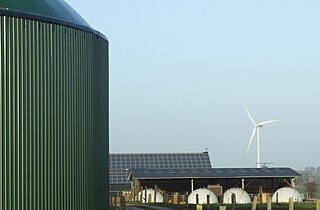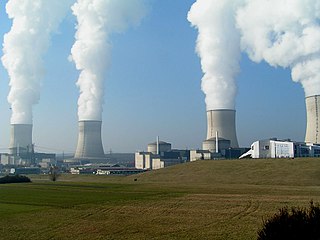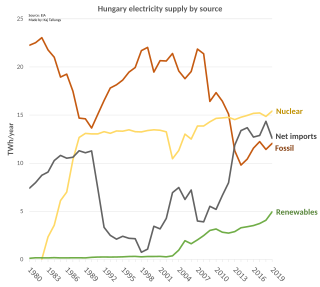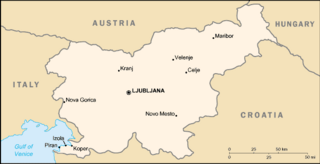This article needs to be updated.(May 2023) |
The Czech Republic is a long-term net-exporter of electricity. [1] 97% -98% of oil used in the Czech Republic is imported. [2]
This article needs to be updated.(May 2023) |
The Czech Republic is a long-term net-exporter of electricity. [1] 97% -98% of oil used in the Czech Republic is imported. [2]
The government's 2015 energy policy designates nuclear power as main source of energy and its share is projected to rise to between 46% and 58% by 2040. Coal-powered energy is planned to fall to 21%, while renewables would rise to 25% and gas range from 5 to 15%. [3]
The updated energy strategy of 2019 envisions a gradual phase out of coal power share in total electricity generation from 2015's 46.2% down to 15.5% by 2040. The strategy sees nuclear energy as a non-carbon source of energy to be used during a slow transition to renewables in order to minimize the use of carbon-emitting fossil fuels that cause climate change. The increase in the share of nuclear, renewables and natural gas is to fill in the energy demand created by the impending gradual shutdowns of coal power stations. [4] This 2015-approved energy strategy expects construction of an additional nuclear reactor in the Temelín Nuclear Power Station and another one in the Dukovany Nuclear Power Station with the possibility of further expansion to two reactors in each power station. The older station of the two, Dukovany, is to be expanded before Temelín. [5] As of 2019, the financing models and contractor selection for the planned reactors are being negotiated by the government. [6]

| Energy source | 2015 | 2040 |
|---|---|---|
| Coal | 46.2% | 15.5% |
| Nuclear | 31.5% | 43.2% |
| Natural gas | 4.8% | 8.2% |
| Renewables | 10.1% | 20.2% |
According to IEA the electricity use (gross production + imports – exports – transmission/distribution losses) in the Czech Republic in 2008 was 67 TWh.

There are two nuclear power plants in the Czech Republic
In 2010 there was photovoltaics (PV) solar power 1,953 MW - fourth top in the EU.
In 2010 there was 471 MW solar heating - 10th top in the EU.
In 2010 there was 215 MW wind power - 18th top in the EU.
| EU and the Czech Republic Wind Energy Capacity (MW) [7] [8] [9] [10] | ||||||||||||||||
|---|---|---|---|---|---|---|---|---|---|---|---|---|---|---|---|---|
| No | Country | 2012 | 2011 | 2010 | 2009 | 2008 | 2007 | 2006 | 2005 | 2004 | 2003 | 2002 | 2001 | 2000 | 1999 | 1998 |
| - | EU-27 | 105,696 | 93,957 | 84,074 | 74,767 | 64,712 | 56,517 | 48,069 | 40,511 | 34,383 | 28,599 | 23,159 | 17,315 | 12,887 | 9,678 | 6,453 |
| 20 | Czech Republic | 260 | 217 | 215 | 192 | 150 | 116 | 54 | 28 | 17 | 9 | 3 | 0 | 0 | 0 | 0 |

Electricity generation is the process of generating electric power from sources of primary energy. For utilities in the electric power industry, it is the stage prior to its delivery to end users or its storage.

Renewable energy plays an important and growing role in the energy system of the European Union. The Europe 2020 strategy included a target of reaching 20% of gross final energy consumption from renewable sources by 2020, and at least 32% by 2030. The EU27 reached 22.1% in 2020, up from 9.6% in 2004, but declined to 21.8% in 2021. These figures are based on energy use in all its forms across all three main sectors, the heating and cooling sector, the electricity sector, and the transport sector.

Energy in the United Kingdom came mostly from fossil fuels in 2021. Total energy consumption in the United Kingdom was 142.0 million tonnes of oil equivalent in 2019. In 2014, the UK had an energy consumption per capita of 2.78 tonnes of oil equivalent compared to a world average of 1.92 tonnes of oil equivalent. Demand for electricity in 2014 was 34.42 GW on average coming from a total electricity generation of 335.0 TWh.

Renewable energy in Germany is mainly based on wind and biomass, plus solar and hydro. Germany had the world's largest photovoltaic installed capacity until 2014, and as of 2021 it has over 58 GW. It is also the world's third country by installed total wind power capacity, 64 GW in 2021 and second for offshore wind, with over 7 GW. Germany has been called "the world's first major renewable energy economy".

Denmark has considerable sources of oil and natural gas in the North Sea and ranked as number 32 in the world among net exporters of crude oil in 2008. Denmark expects to be self-sufficient with oil until 2050. However, gas resources are expected to decline, and production may decline below consumption in 2020, making imports necessary. Denmark imports around 12% of its energy.

Renewable energy in the United Kingdom contributes to production for electricity, heat, and transport.

Energy in Finland describes energy and electricity production, consumption and import in Finland. Energy policy of Finland describes the politics of Finland related to energy. Electricity sector in Finland is the main article of electricity in Finland.

Energy in Belgium describes energy and electricity production, consumption and import in Belgium.

The electricity sector in France is dominated by its nuclear power, which accounted for 71.7% of total production in 2018, while renewables and fossil fuels accounted for 21.3% and 7.1%, respectively. France has the largest share of nuclear electricity in the world, and together with renewable energy supplies, this has helped its grid achieve very low carbon intensity.

Electricity sector in Luxembourg describes electricity issues in Luxembourg. Luxembourg is a member of OECD and European Union. Luxembourg imports most of its energy. Luxembourg is the EU country with the second smallest forecast of renewables in 2020. Luxembourg has one of the highest emissions of carbon dioxide per person in Europe.
South Africa has a large energy sector, being the third-largest economy in Africa. The country consumed 227 TWh of electricity in 2018. The vast majority of South Africa's electricity was produced from coal, with the fuel responsible for 88% of production in 2017. South Africa is the 7th largest coal producer in the world. As of July 2018, South Africa had a coal power generation capacity of 39 gigawatts (GW). South Africa is the world's 14th largest emitter of greenhouse gases. South Africa is planning to shift away from coal in the electricity sector and the country produces the most solar and wind energy by terawatt-hours in Africa. The country aims to decommission 34 GW of coal-fired power capacity by 2050. It also aims to build at least 20 GW of renewable power generation capacity by 2030. South Africa aims to generate 77,834 megawatts (MW) of electricity by 2030, with new capacity coming significantly from renewable sources to meet emission reduction targets. Through its goals stated in the Integrated Resource Plan, it announced the Renewable Energy Independent Power Producer Procurement Programme, which aims to increase renewable power generation through private sector investment.
The Polish energy sector is the sixth largest in Europe. The scale of energy consumption in 1996–2015 increased from 139,593 GWh to 161,438 GWh. According to the data of Polskie Sieci Elektroenergetyczne (PSE), electricity production in October 2020 amounted to 13,553 GWh; domestic consumption amounted to 14,798 GWh.

Energy in Sweden describes energy and electricity production, consumption and import in Sweden. Electricity sector in Sweden is the main article of electricity in Sweden. The Swedish climate bill of February 2017 aims to make Sweden carbon neutral by 2045. The Swedish target is to decline emission of climate gases 63% from 1990 to 2030 and international transportation excluding foreign flights 70%. By 2014 just over half of the country's total final energy consumption in electricity, heating and cooling and transport combined was provided by renewables, the highest share amongst the then 28 EU member countries. About a third of Sweden's electricity is generated by nuclear power. In generating a year's worth of this energy, Swedes generate about 4 tonnes of CO2 emissions each. Since 2010, sustainability measures have reduced total emissions even as the population has increased.

Energy policy of Finland describes the politics of Finland related to energy. Energy in Finland describes energy and electricity production, consumption and import in Finland. Electricity sector in Finland is the main article of electricity in Finland.

Energy in Hungary describes energy and electricity production, consumption and import in Hungary. Energy policy of Hungary describes the politics of Hungary related to energy.
Energy in Luxembourg describes energy and electricity production, consumption and import in Luxembourg. Energy policy of Luxembourg will describe the politics of Luxembourg related to energy in greater detail. Electricity sector in Luxembourg is the main article of electricity in Luxembourg.

Primary energy use in Slovakia was 194 TWh and 36 TWh per million inhabitants in 2009.

Total primary energy supply (TPES) in Slovenia was 6.80 Mtoe in 2019. In the same year, electricity production was 16.1 TWh, consumption was 14.9 TWh.
Renewable energy in the Czech Republic describes the renewable energy related development in the Energy in the Czech Republic.

Hungary is a member of the European Union and thus takes part in the EU strategy to increase its share of renewable energy. The EU has adopted the 2009 Renewable Energy Directive, which included a 20% renewable energy target by 2020 for the EU. By 2030 wind should produce in average 26-35% of the EU's electricity and save Europe €56 billion a year in avoided fuel costs. The national authors of Hungary forecast is 14.7% renewables in gross energy consumption by 2020, exceeding their 13% binding target by 1.7 percentage points. Hungary is the EU country with the smallest forecast penetration of renewables of the electricity demand in 2020, namely only 11%.